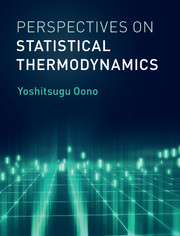Book contents
- Frontmatter
- Dedication
- Contents
- Preface
- Acknowledgements
- Self-Study Guide
- List of Symbols
- Part I Atomic and Mesoscopic Viewpoint
- 1 Introduction
- 2 Atomic Picture of Gases
- 3 Introduction to Probability
- 4 The Law of Large Numbers
- 5 Maxwell's Distribution
- 6 Delta Function and Density Distribution Functions
- 7 Mean Free Path and Diffusion
- 8 Introduction to Transport Phenomena
- 9 Brownian Motion
- 10 The Langevin Equation and Large Deviation
- Part II Statistical Thermodynamics: Basics
- Part III Elements of Phase Transition
- Appendix Introduction to Mechanics
- Bibliography
- Index
1 - Introduction
from Part I - Atomic and Mesoscopic Viewpoint
Published online by Cambridge University Press: 24 November 2017
- Frontmatter
- Dedication
- Contents
- Preface
- Acknowledgements
- Self-Study Guide
- List of Symbols
- Part I Atomic and Mesoscopic Viewpoint
- 1 Introduction
- 2 Atomic Picture of Gases
- 3 Introduction to Probability
- 4 The Law of Large Numbers
- 5 Maxwell's Distribution
- 6 Delta Function and Density Distribution Functions
- 7 Mean Free Path and Diffusion
- 8 Introduction to Transport Phenomena
- 9 Brownian Motion
- 10 The Langevin Equation and Large Deviation
- Part II Statistical Thermodynamics: Basics
- Part III Elements of Phase Transition
- Appendix Introduction to Mechanics
- Bibliography
- Index
Summary
Summary
* Science is an empirical endeavor.
* The world in which we live seems to permit microscopic, mesoscopic, and macroscopic descriptions.
* The macroscopic description is in terms of observables and concepts meaningful at the scale of our daily lives.
* The microscopic description is in terms of particles and fields that underlie our world.
* We see why atoms andmolecules are so small compared to us. Thus, the law of large numbers is crucial to relate the macro and micro worlds.
* The mesoscopic description describes fluctuations deviating from the law of large numbers.
* The study of large deviation is the key to understanding fluctuations.
Key words
three levels of description: microscopic, mesoscopic, macroscopic
Everybody knows that the materials we see around us are made of atoms and molecules. We could even see them, for example, with the aid of atomic force microscopes. However, only 50 years ago no one could see atoms. About 100 years ago the existence of atoms was still disputed.
Atomisms, Ancient and Modern
The idea that the world is made of indivisible and unchanging minute particles (atomism) is, however, not a very unique idea. After all, it seems that there are only two choices: (i) the world is infinitely divisible and continuous or (ii) the world is made of indivisible units separated by void (we ignore various easy combinations of these ideas here).
Leucippus (fifth century BCE) is usually credited with inventing atomism in Greece. His disciple Democritus (c. 460–370 BCE) systematized his teacher's theory. The early atomists tried to account for the formation of the natural world by means of atoms and void alone. The void space is described simply as nothing, or the negation of body. Atoms are, by their nature, intrinsically unchanging, but can differ in size, shape, spatial position (and orientation), etc. They move in the void and can temporarily make clusters according to their shapes and surface structures. The changes in the world of macroscopic objects were understood to be caused by rearrangements of the atomic clusters. Thus, atomism explains changes in the macroscopic world without creating new substance. All the macroscopic phenomena are naturally ephemeral.
- Type
- Chapter
- Information
- Perspectives on Statistical Thermodynamics , pp. 3 - 11Publisher: Cambridge University PressPrint publication year: 2017

